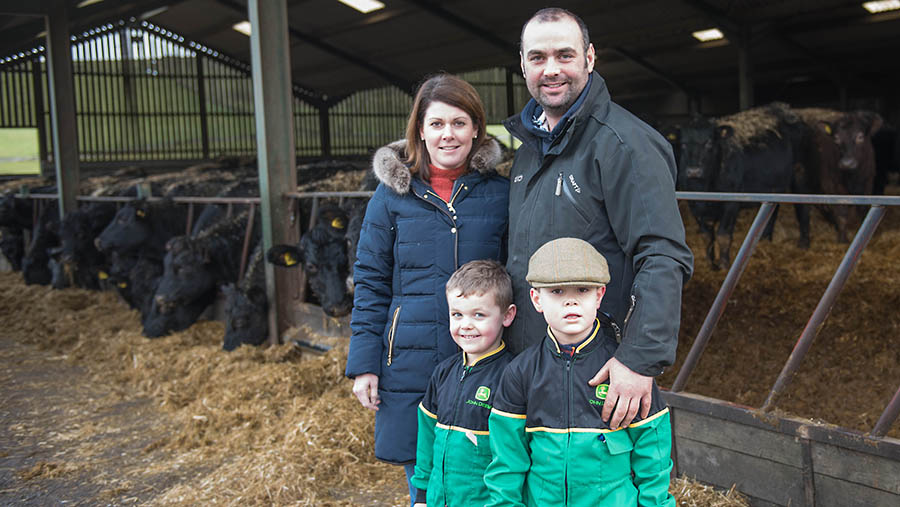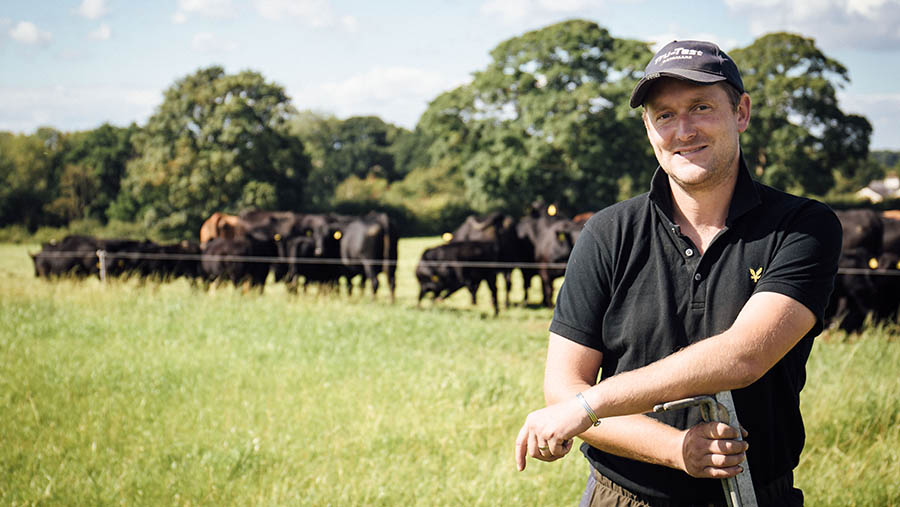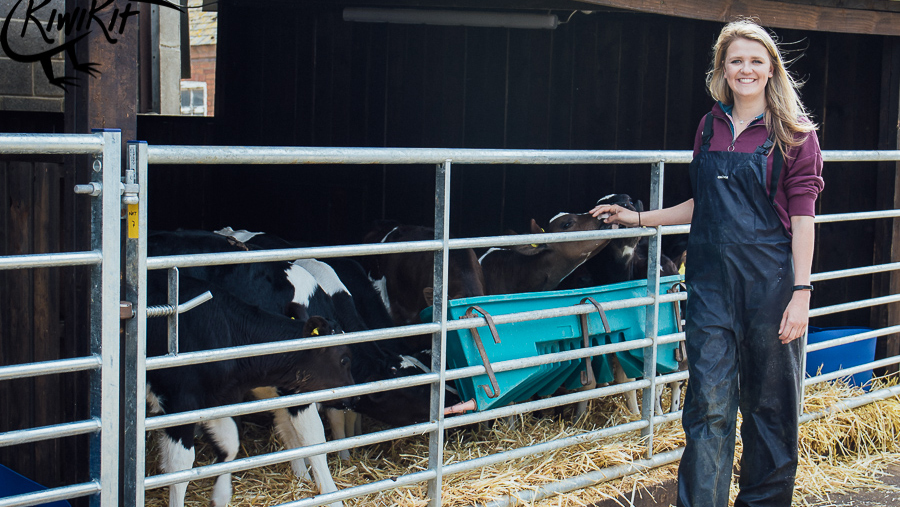Advertiser content
Swing into spring – cattle tags, electric fencing and feeders
With spring calving rapidly approaching, immediate thoughts turn to tagging and feeding our new arrivals ensuring we can identify them easily allowing us to monitor progress and give them the best start possible.
A little further away as the days slowly lengthen, thoughts will also turn to containment on grassland to make the most from grass and how electric fencing can be both flexible and save you time.
Ian Richardson uses Alpha cattle tags for managing his cows for #EasyCattleTagging

Ian Richardson with his family
Scottish Borders livestock farmers Ian Richardson and his father David Farm 1,650 acres at Upper Samieston, near Jedburgh in the Scottish Borders running 440 suckler cows which they are building up to total 500, alongside 1,000 breeding ewes plus 250 arable acres.
The Richardson’s aim is to sell suckler calves off their dams to maximise profitability ideally in October.
Ian explains; “We aim to sell at weaning because we don’t have space and they make us the most profit then. They cost us virtually nothing to graze through the summer”.
They are using Charolais, Aberdeen Angus, Limousin, British Blue and Simmental bulls, using the Angus, Blues and some Limousins for breeding replacements and putting the Charolais and Limousin bulls onto them.
The Richardson’s have taken home the champion calf prize at Stirling on numerous occasions. A handful are selected as potential show calves receiving no special treatment other than a wash and a blow dry, but still take the accolades particularly in the Young Farmers Calf Rally at Stirling.
Most of the herd calve in spring from mid-March to May and calving is as tight as possible so tasks like tagging is full on.
The Richardson’s now rely on Roxan’s Alpha cattle tags to identify cattle and pair up cows and their calves quickly. They trust in TagFaster too for their sheep and like the speed and good retention they get.
“We had a bad experience with our previous cattle tag supplier and now we replace very few tags. Any we do and delivery is often next day. Out of 413 calves born, we probably replaced less than six”.
“The Angus calves are all tagged with a red management tag so we can pick them out regardless of the sire. We also freeze-brand all the cows, to aide field identification. The large handwritten management tag enables us to match the calf quickly with the mother’s freeze brand” Ian adds.
Look out for more Upper Samieston progeny and you will be sure to be impressed.
Browse our range of cattle tags online at Roxan
Browse our range of cattle tags online at KiwiKit
Ian Norbury uses rotational grazing to #GetMoreFromGrass

Ian Norbury
A decade ago, Ian Norbury came back to the family farm full. The Mobberley Angus beef brand he produces is making great strides.
Ian has increased the numbers of cattle from 60 cows six years ago and is aiming for 150 suckler cows +followers to total 300 to make full use of the available land. Any stock born on-farm stays until slaughter or is sold as breeding stock.
The journey to rotational grazing for Ian at Mobberley started on a Cornish farm open day after seeing a KiwiTech water trough – moveable along with a back fence too as stock are moved onto a new Cell of fresh grazing. Therefore, no longer relying on the static concrete troughs left over from their dairy cow days.
The biggest obstacle Ian feels for many to rotational grazing is additional infrastructure requirements, and that ticked the watering box. Next, was fencing.
Ian now runs a PEL820 Mains Energizer with a remote powering over 250 acres, and explains;
“The power is amazing, as it runs some double-fenced lines as well. This goes around all the fields and temporary fencing feeds off this to create the cells”. That box is well and truly ticked off too.
Starting with strip grazing, but the introduction of a back fence, Ian’s grass addiction has grown! Within 24 hours of the field being closed you start to see re-growth – it’s like magic”!
Ian also admits; “Electric fencing is addictive too! It is like a Swiss Army Knife – there are so many ways to use it, and to run power off it. It is so fast and quick to put up a permanent structure, then hook a temporary fence off it -tidy and quick”.
Having permanent electric fence, fed off the mains, saves so much time, from setting up the field for forward grazing blocks, plus the hedge is better quality and offers more protection.
Ian is breeding for a smaller suckler cow – he wants a cow that is 650kg, he does not need a 1000kg cow, as he wants a weaning calf of around 325kg – around half the weight of the cow.
This cow and calf can utilise the grass, stay out for longer and do less damage to the ground and soil structure, whilst still producing an ideal weight with excellent confirmation and carcass quality – this is easier for them to achieve than a one tonne cow producing a 500kg calf, which would need to be finished on concentrates and is not what retailers want either.
With a tightened calving pattern to reduce the spread of the average weight, this is easier to manage a group and get a good average weight. Pros and Cons, the con being the butcher wants a supply all year round!
Ian has been rotational grazing for over 4 years now and would not go back to set stocking and a grass habit feeds his cow addiction too.
Visit Roxan for all your fencing needs
Visit KiwiKit for all your fencing needs
Stallion calf feeders are #UdderlyDifferent

@thedairydaughter – brand ambassador for KiwiKit
With spring not far away thoughts in many dairy units will be on rearing new dairy calves on milk replacer, good hygiene and nutrition is essential as well as sufficient high-quality colostrum.
As well as these factors mentioned, rearing calves on a teat system offers huge benefits too as the muscular folds forming the oesophageal groove are stimulated by warmth and suckling as opposed to drinking from a bucket.
Feeding milk replacer at the correct temperature (made up with warm water at 45°C and fed at 37–39°C) and using teats stimulate the oesophageal groove to open best.
As milk enters the abomasum it forms a firm clot within a few minutes under the influence of the enzyme’s rennin and pepsin. This clotting process slows down the rate at which milk flows out of the abomasum, allowing nutrients to be released and digested better.
It can take as long as 12–18hrs. for this milk curd to be fully digested.
The milk fat that is embedded in the milk curd is broken down by another enzyme which is called lipase which is secreted from saliva in the mouth.
Teat feeding slows milk intake compared to that of bucket feeding. A suckling calf therefore produces far more saliva which is incorporated as milk is swallowed. (Source: Digestion of feeds in the milk-fed calf. CSIRO.AU).
Calves reared on slower flow teats were observed to eat more starter mix and then as a result, had faster digestive process development including the all-important rumen, putting them in a better position to consume and digest sufficient forage after weaning with no growth check.
Daily liveweight Gain (DLWG) of calves on the slower flow teats was observed to be higher. It was also suggested that nutritional scours could be reduced especially at peak milk consumption when calves are voracious feeders with better curd formation preventing nutrients flowing through undigested. (Source: Influence of teat flow rate in commercial milk feeding, Cambridge University 2015).

Figure 1: Cross section of a slow flow teat
Slower flowing teats if possible manufactured from a natural rubber mimic the udder and no more fluid passes through it than naturally would, allowing the calf to suckle more intensely.
Internal collapsing flap-valves holds the milk in the teat making it much more responsive to the calf’s needs.
Selecting high quality calf feeding equipment that incorporates slow flow teats is a sensible decision that not only improves digestion but also ensures longevity and assists in hygiene.
Feeders made from polyethylene that is both tough and durable but easily cleaned is preferable.
Open tops and ergonomically moulded units can be thoroughly cleaned quicker and easier. Less milk residue build-up and the ability to dry naturally after cleaning reduce bacteria growth too.
The ‘Smart Cow Teat and Cap’ or ‘Peach Teat’ is designed to fit all Stallion feeders. A Stallion Smart Cow Teat is fitted with a removable valve and designed for calves from 1-6 weeks and can be used with or without the valve.
The Smart Cow teat with the valve is ideal for calves 1-6 weeks as it helps the calves drink milk. When calves are older than 6 weeks, simply remove the valve as the calves have to suck harder, helping to further stimulate the saliva for better rumen development and improved PH-levels and curds in the abomasum lead to better digestion.
Healthy calves maximising their genetic potential is the outcome we all want and Stallion can help achieve this outcome.
View our range of Stallion calf feeders at Roxan
View our range of Stallion calf feeders at KiwiKit
Switch and upgrade
Time to upgrade?
No compromise on quality, choice, service or support when you Switch & Upgrade to any product lines from KiwiKit and Roxan.
Whether for tagging, EID reading, feeding or fencing, our products offer complete solutions for farmers to minimise cost and maximise output while ethically rearing productive and healthy livestock.
Provided by
KiwiKit bring New Zealand Solutions for British Farmers, Fencing Contractors and Veterinary Surgeons. Our aim is to provide good quality product that will do the job at the right price with a first class service to our customers. KiwiKit has a long history of bringing innovative products to the UK market and providing our customers with choice and quality with products that add value to your enterprise, or your lifestyle. ROXAN provide the world’s leading brands in livestock management systems from the fully automatic ear tagging system for sheep, TagFaster, to the accurate animal health delivery systems from Simcro and easy to use EID readers from Tru-Test.
